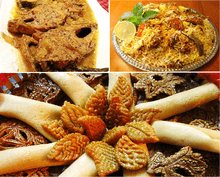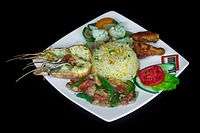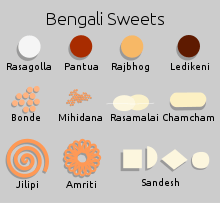Bangladeshi cuisine
Bangladeshi cuisine (Bengali: বাংলাদেশের রান্না) is the national cuisine of Bangladesh. Bangladeshi cuisine has been shaped by the diverse history and river-line geography of Bangladesh. The country has a tropical monsoon climate.
Bangaliketa (Etiquette)
Bangladeshi people follow certain rules and regulations while eating. It includes warm hospitality and particular ways of serving as well. This is known as Bangaliketa (Bengali: বাঙালি কেতা). The culture also defines the way to invite people to weddings and for dinner. Gifts are given on certain occasions. Bangaliketa also includes a way of serving utensils in a proper manner.[1]
Culinary style and influences

Bangladeshi cuisine has over time been largely influenced by the Mughlai cuisine left behind by the Persian Rulers. This has led Bangladeshi cuisine to include many rich aromatic dishes such as biriyani and korma that requires the use of a large array of spices along with an extensive amount of ghee. Dhaka being the Mughal Capital of the Bengal Subah (Which Includes the modern Bangladesh and the Indian states of West Bengal) was a major trading center in South Asia, so many culinary styles from around the world influenced the city's cuisine. After Dhaka became the capital of East Bengal, Bangladesh the populace began to adopt the cuisine of the city with many unknown Persian, Turkish and Arabic influenced dishes becoming hugely popular.[2]
Specialties by region
| Name | Course | Producing region | Description |
|---|---|---|---|
| Balish Misti | Dessert | Netrokona | Balish Mishti (lit. pillow sweet), called because of its pillow-like shape and huge size, has a history of almost hundred years.[3] |
| Bograr Doi (Yogurt of Bogra) |
Dessert | Bogra | In Bangladesh the most famous variation of Mishti Doi is in Bogra and people of Bogra are known to make the best Mishti Doi[4] |
| Comillar Ras malai | Dessert | Comilla | Ras malai or rossomalai is a dessert originating from the Indian subcontinent. Ras malai consists of sugary white cream, or yellow-coloured (flattened) balls of chhana soaked in malai (clotted cream) flavoured with cardamom. Rasmalai of Comilla created by "Matree Bhandar" is the best and oldest in Bangladesh. It is very popular sweet all over the country.[5][6] |
| Chowk Bazaar Iftar | All courses | Old Dhaka | Chowk Bazaar was one of the most famous business and social meeting centres of Dhaka in the Mughal period. During Ramadan Chowk Bazaar is famous for its Iftar items which include Moghul cuisine and other traditional items. Almost 500 different types of Ifter are prepared for Holy Ramadan.[7][8][9] |
| Chui Jhal Mangsho | Main course | South Bengal | Piper chaba is called চুই ঝাল (Chui Jhal) or চই ঝাল (Choi Jhal) in the South Bengal region of Bangladesh. People in Bangladesh's south-western districts like Khulna, Jessore, Bagerhat, Satkhira and Narail cut down the stem, roots, peel the skin and chop it into small pieces - and cook them with meat and fish, especially with mutton. It is a relatively expensive spice in Bangladesh, and the roots are usually more expensive than the stems because of their stronger aroma. The taste is similar to horseradish. |
| Dhakai Bakarkhani | Entrée | Old Dhaka | Bakarkhani or BaqarKhani, also known as bakar khani roti, is a thick, spiced flat-bread that is part of the Mughlai cuisine of the Indian subcontinent. Dhakai Bakarkhani, the traditional food/snack of the people of old Dhaka is famous for its quality and taste. Bakarkhani is mainly dished up with tea.[10][11] |
| Haji Biriyani | Main course | Old Dhaka | Haji Biriyani (also known as Hajir Biriyani) is the Chevon biryani dish made with highly seasoned rice and goat's meat. The recipe includes highly seasoned rice, chevon, mustard oil, garlic, onion, black pepper, saffron, clove, cardamom, cinnamon, salt, lemon, doi (yogurt), peanuts, cream, raisin and small amount of cheese (either cow or buffalo). The recipe has been handed over the founder of the restaurant to his next generation.[12] |
| Kala bhuna | Main course | Chittagong | Beef Kalo/Kala Bhuna is one of the famous beef recipe in Bangladesh. And the specialty of the recipe is its spices. Beef shoulder pieces are cooked with traditional spices till become dark and tender. Kala buna and Mejbani Mangsho preparations are signature dishes of the port city Chittagong. |
| Mejbani Mangsho | Main course | Chittagong | The Chittagong region is famous for spicy and hot curries – mainly of beef.[13] Mejbani Gosht is very popular and famous. Mezban is a Persian word literally meaning a host.[14] The word now means 'community feasting', a tradition that originated in Dhaka region. |
| Muktagachar monda | Dessert | Muktagachha, Mymensingh | Monda is a traditional sweetmeat. The sweet, first made in 1824,[15][16] is reputed in Bangladesh and many countries for its originality, taste and flavour.[15] |
| Natorer Kachagolla (Kachagolla of Natore) |
Dessert | Natore | Natore in the Rajshahi Division is famous for Kachagolla. Though it is called golla (means small ball in native Bengali languages) but it has no common shape like other sweetmeat items. It is made of pure chhena or paneer (which is made by curdling the milk and separating the whey from it) and sugar. |
| Porabarir/Tangailer Chomchom (Chomchom of Tangail) |
Dessert | Porabari, Tangail | Chomchom, cham cham, or chum chum (Bengali: চমচম) is a traditional Bengali sweet originated from Porabari, Tangail, Bangladesh. It is a very popular dessert in Bangladesh and India. The sweet is oval and brownish. |
| Seven Color Tea | Beverage | Moulvibazar | Seven-colour tea or seven-layer tea is a well-known hot beverage in Bangladesh.[17][18] Romesh RamGour invented the seven-layer tea after discovering that different tea leaves have different densities.[19][18] Each layer contrasts in colour and distinct taste, from syrupy sweet to spicy cloves. The result is an alternating dark/light band pattern throughout the drink giving the tea its name. |
| Shatkora beef | Main course | Sylhet | In Bangladesh, the thick fleshy rind of the Citrus macroptera, known as Shatkora, is eaten as a vegetable. It has a unique taste and aroma. The thick rind is cut into small pieces and cooked (either green or ripe) in beef, mutton, and fish curries. Curries cooked with shatkora and beef or mutton is now served in many Bangladeshi/Indian restaurants in the UK. A beef shatkora dish cooked by local chefs in Sylhet, Bangladesh (where the shatkora originates from) is featured in the British celebrity chef Rick Stein's cookery programme Rick Stein's Far Eastern Odyssey (Episode 6), which was broadcast by the BBC on 20 August 2009. |
Shutki chatni |Main course |kulaura |In molvibazar kukaura its foun, the thick fleshy rind of the Citrus macroptera, known as Shatkora, is eaten as a vegetable. It has a unique taste and aroma. The thick rind is cut into small pieces and cooked (either green or ripe) in beef, mutton, and fish curries. Curries cooked with shatkora and beef or mutton is now served in many Bangladeshi/Indian restaurants in the UK. A beef shatkora dish cooked by local chefs in Sylhet, Bangladesh (where the shatkora originates from) is featured in the British celebrity chef Rick Stein's cookery programme Rick Stein's Far Eastern Odyssey (Episode 6), which was broadcast by the BBC on 20 August 2009. |}
See also
Further reading
- Bangladeshi Restaurant Curries, Piatkus, London – ISBN 0-7499-1618-4 (1996)
- Curries – Masterchef Series, Orion, London – ISBN 0-297-83642-0 (1996)
- Curry, Human & Rousseau, South Africa – ISBN 0-7981-3193-4 (1993)
- Kerrie, in Afrikaans, Human & Rousseau, South Africa – ISBN 0-7981-2814-3 (1993)
- Petit Plats Curry, French edition, Hachette Marabout, Paris – ISBN 2-501-03308-6 (2000)
- 2009 Cobra Good Curry Guide, John Blake Publishing, London – ISBN 1-84454-311-0
- Bangladesh – Mariam Whyte, Yong Jui Lin
- World and Its Peoples: Eastern and Southern Asia – Marshall Cavendish Corporation –
- Bangladesh – Stuart Butler
- Bangladeshi Cuisine – Shawkat Osman
- Multicultural Handbook of Food, Nutrition and Dietetics
References
- "Country Guides & Profiles - Business - Kwintessential UK".
- "Bangladesh cuisine part I - delectable and diverse". The Daily Star. 6 December 2016. Retrieved 15 March 2019.
- "Top Ten Famous Sweets of Bangladesh". #Foodiez.
- Hossain, Md. Rakib (14 August 2014). "Yogurt of Bogra (Bograr Doi)".
- "- Rasmalai in Matri Bhandar". offroadbangladesh.com.
- "Succulent Rasmalai of Comilla". Daily Sun. 20 June 2016. Retrieved 17 September 2018.
- "Eyewitness: Chak Bazar iftar market in old Dhaka". The Guardian.
- Auzias, Dominique; Labourdette, Jean-Paul (2016). BANGLADESH 2017 Petit Futé. Petit Futé. pp. 133–. ISBN 979-10-331-4296-6.
- "Dhaka Chawk Bazar Meetup". 1 June 2017.
- "Old Dhaka Bakarkhani – A Legendary Bread". 19 October 2013.
- "Bakarkhani: delight in every bite". Daily Sun. 24 April 2016. Retrieved 17 September 2018.
- Mydans, Seth (8 July 1987). "For a secret stew recipe, time is running out". The New York Times. Retrieved 30 April 2015.
- "MAJESTIC MEZBAN". 11 October 2013.
- "Sweetmeat Monda: A rich tradition". The Daily Star. 8 July 2012. Retrieved 19 August 2017.
- "Six sweetmeats which branding Bangladesh". Daily Sun. Retrieved 19 August 2017.
- "সিলেটের সাতরঙা চা এর রহস্য ভেদ, জানুন তৈরির নিয়ম" সিলেটের সাতরঙা চা এর রহস্য ভেদ, জানুন তৈরির নিয়ম. The Daily Prothom Alo (in Bengali). Archived from the original on 4 May 2017. Retrieved 4 November 2017.
- "Making rainbows in a glass – seven-layer tea in Bangladesh". The Guardian. Retrieved 2 November 2017.
- "One Glass, Seven Layers of Tea - Scene Asia". Wall Street Journal Blog. Retrieved 7 November 2017.
External links



